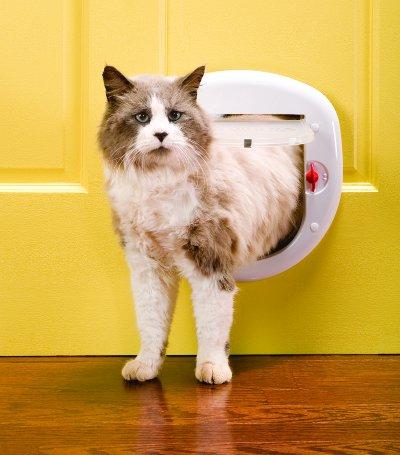
September 16, 2015
PetSafe® Expert
Amy Shojai, CABC
Can Cats Use Dog Doors?
A cat is always on the wrong side of the door, according to the cat anyway. They drive us crazy with meow-demands to open the door, let them in, let them out, with rarely any rhyme or reason to their requests.

There are too many risks involved to allow cats or dogs to roam outside unsupervised. Where I live in North Texas, coyotes come right up on the back patio and would love to munch my Karma-Kat or Seren-Kitty. But if partnered with a safe area, a pet door offers lots of convenience for pet parents and their cats, especially when you aren't home to do door duty.
Cat-Centric Benefits of Pet Doors
While dog doors typically give access to the back yard, there are multiple ways a pet door benefits Kitty. Think outside the cat box and use a pet door to manage your multi-pet household, as well as potential behavior issues.

Access to Litter Box
Cats require easy access to their potty place, but the litter box can be the most challenging part of living with a cat. Felines that used to be strays may refuse to use indoor facilities and prefer grass, for instance. Or your family may include dogs or toddlers that get into the box (ew!). You can situate the cat litter box on an enclosed back porch, in the garage, within a cat condo, or in another safe secure enclosure and offer the cat in-and-out privileges via the pet door.
Smorgasbord Situations
When you have only one cat, this may not be important, but most folks share their lives with more than one feline. If you also have a dog, managing mealtimes may be a challenge, especially when each animal requires a different diet. Using a pet door to keep some pets out while giving others access can solve the problem of managing multiple meals.
Managing Spaces
Every home is different, and the dynamic may change as pets are adopted, grow up, and become seniors. For safety, you may wish to segregate some pets from stairwells, for instance, while still allowing others to visit the upstairs cat trees. Pet doors can allow specific pets access while keeping others out.
Kinds Of Pet Doors

Pet doors can be installed in interior or exterior walls, doors, windows, or even sliding panels to give access to an inside room, or safe outdoor area. Cats love window watching, so this can be a great option when the pet door unit simply fits into the existing opening.
The simplest type of pet door offers a finished opening that's too small for other pets, and is used for access into interior rooms. The next level provides a vinyl flap that covers the opening for the dog or cat to push through, and protects against wind and wet.
More expensive models provide a hinged screen or window, which keeps the opening free from buggy intruders or seals air conditioning inside. Most of these can be "locked" so that the cat stays safely inside when you're not there to keep an eye on his antics.
The ultimate in pet doors offer "keyed" access that lock so that only the pet wearing the magnetic collar or microchip ID can get into the house. That prevents strays or wild animals like skunks and coyotes from invading your home, and allows only the designated cat to come and go through that particular portal.
Measure the cat's height at his shoulders to determine the size door needed. Remember that kittens may have some growing yet to do. If you have other pets, decide if you want them to have access too, before deciding on the size of the door.
How to Teach Cats to Use Pet Doors

Dogs and cats naturally nose poke, paw, and sniff objects to explore and play with their world. Cats also use cheek-rubs to mark territory. Use this natural inclination to teach Kitty to push through the flap, or to approach the entrance and trigger it open.
Prop the door flap open so the pet can see through to the other side. Use a favorite treat or toy to repeatedly lure her back and forth through the opening until she becomes used to the idea. Remember to praise her lavishly when she's brave and pushes through the door. It can be a bit off-putting to shy kitties to take that first dare, so be sure that the reward on the other side (play, treats, games, praise) gives her good reason to remember the game so she's eager to repeat.
Reward even a nose touch to encourage the behavior. Try rubbing a bit of something smelly like a fishy treat, catnip or even mint oil on the surface of the flap. That can increase kitty curiosity to explore and nose touch.
When the pet first pushes through, have a favorite treat waiting and reward her on the other side. Be sure to give her time and show her the location of the litter box or food bowl, for instance, so your cat knows what's beyond the barrier. Once she understands that there MAY be a treat waiting, she'll be more inclined to use the doggy door (and the bathroom facilities or play opportunities) whether a treat awaits or not.
Once your cat knows how to use a pet door, the pester quotient will go down. And you won't have to worry about Kitty comings and goings, whenever he has the urge to explore, play, munch, or poop.
Get Email Updates
Subscribe to the latest news, promotions, & more from PetSafe® brand.
Sign up today for the latest news, promotions, and more from PetSafe® brand.





